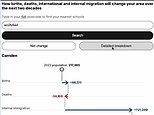
Nearly 30 councils are set to welcome at least 200,000 immigrants each over the next two decades, projections reveal.
That is, for context, enough people to fill Norwich or Reading.
Government data laying bare how mass migration is going to transform Britain shows that in Birmingham alone, another 543,000 foreign nationals are expected to call the city home by 2047.
This figure is the equivalent to 47 per cent of the local authority’s current population, thought to be around 1.15million.
But looking at the immigration statistics this way excludes hundreds of thousands of residents who will emigrate between now and then. Doing so also fails to factor into account internal migration, births and deaths.
This makes it impossible to predict exactly how many residents will be immigrants in all of England’s 330-plus local authorities.
The population projections, published by the Office for National Statistics this week, gave a stark glimpse of the future.
Nationwide, England’s population is set to increase from 57m to 64m by 2047.
But the overall numbers laid bare sharp differences in fortunes between local areas.
According to the ONS projections, South Derbyshire will grow by 38 per cent over the time period to accommodate 153,000 people.
No other council, with the exception of the City of London, is expected to undergo a bigger expansion in terms of percentage growth.
In contrast, Gosport’s population is projected to fall by 4 per cent to 79,000, mainly because of deaths outstripping births. This is the largest decline in the country.
In terms of raw figures, Birmingham is set to see the greatest number of immigrants (542,957), followed by Manchester (462,486) and Newham (456,342) between 2022 and 2047.
But when compared against current populations, Westminster tops the table – when excluding City of London.
In that London borough, almost 50,000 immigrants are set to arrive in the next two decades.
By comparison, only 11,500 people live there at present.
All but seven authorities will see a net increase in international migration – defined as more people from overseas arriving than leaving.
The councils which buck the trend are Fylde, South Hams, Isles of Scilly, Ribble Valley, North Kesteven, Amber Valley and Rutland.
One of the country’s most esteemed voices on immigration believes the public has had enough over the past few years.
Professor David Coleman, emeritus professor of demography at the University of Oxford and co-founder of pressure group of Migration Watch, said: ‘Some focused immigration, preferably without dependents is desirable.
‘But it is well known that immigration cannot “solve” population ageing, only moderate it. Otherwise more and more migrants are needed, leading to astronomical population growth.
‘But it is absurd to speak of more immigration after the huge recent inflows. Surely the public will not endure it?
‘We have nothing to show by way of prosperity from the very large number of immigrants in recent years.’
Alp Mehmet, of Migration Watch UK, said: ‘Immigration is now the sole driver of unprecedented of population growth.
‘The pace of demographic change is ever more rapid while the reshaping of our society as deaths exceed births will soon be irreversible.
‘The solution is not more immigration, which has for decades been a net cost to the exchequer. All that will do is add to our future problems. Much better to create conditions that encourage families to grow.’
As well as high levels of immigration, England’s changing demographics are set to be supercharged by falling birthrates in the UK.
Deaths are set to outnumber births in two-thirds of all authorities, the ONS estimates also show.
Demographers claim the free falling figures mean we may need to become reliant on immigration to prop up our economy and avoid the threat of ‘underpopulation’.
Otherwise, the nation could be left with too few younger people to work, pay tax and look after the elderly.
Keir Starmer unveiled a crackdown on immigration last month, warning that failure to control the system risked turning Britain into an ‘island of strangers’.
Downing Street was forced to deny angry comparisons from MPs that it was an echo of Enoch Powell’s infamous ‘Rivers of Blood’ speech.
Scrambling to blunt the threat of Reform, Sir Keir vowed to give Brits what they had ‘asked for time and time again’ as he announced a package to ‘take back control of our borders’.
Under Number 10’s long-awaited blueprint to curb immigration, skills thresholds will be hiked and rules on fluency in English toughened. Migrants will also be required to wait 10 years for citizenship rather than the current five and face deportation for even lower-level crimes.
Policymakers estimate the government’s package will bring down annual inflows by around 100,000.











